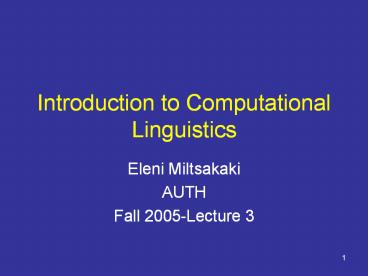Introduction to Computational Linguistics - PowerPoint PPT Presentation
Title:
Introduction to Computational Linguistics
Description:
Identify every major phrase in the following sentences. ... Selectivity. The range of sentences that can be identified as ungrammatical. Understandability ... – PowerPoint PPT presentation
Number of Views:148
Avg rating:3.0/5.0
Title: Introduction to Computational Linguistics
1
Introduction to Computational Linguistics
- Eleni Miltsakaki
- AUTH
- Fall 2005-Lecture 3
2
Review exercise 1
- Identify every major phrase in the following
sentences. Indicate the head and any complements
of the head. - The man played his guitar in the street
- The people dissatisfied with the verdict left
the courtroom
3
Review exercise 2
- Classify the following verbs as being
intransitive, transitive or ditransitive. If the
verb can be used in more than one of these forms,
give each possible classification. Give an
example sentence to demonstrate your analysis. - Cry
- Sing
- Donate
- put
4
Review exercise 3
- Parse the following sentences
- The old man put his violin in its case
- We had to call off the meeting until next Monday
5
What makes a good grammar?
- Generality
- The range of sentences covered by the rules
- Selectivity
- The range of sentences that can be identified as
ungrammatical - Understandability
- How simple the grammar is
6
Hint for making rules general
- Pay attention to constituents
- Diagnostic of constituency
- Conjunction
- Compare
- I ate a hamburger and a hot dog
- I will eat the hamburger and throw away the hot
dog - I ate a hamburger and John ate a hot dog
- I ate a hamburger and on the stove
- I ate a cold hot dog and well burned
- I ate the hot dog
7
How the conjunction test can help
- Compare
- I looked up Johns number
- I looked up Johns chimney
- I looked up Johns number and in his cupboards
- I looked up Johns chimney and in his cupboards
8
Parsing strategies
- Top-down
- A top down parser starts with S and attempts to
rewrite it into a sequence of terminal symbols
that matches the words in the input sentence - Bottom-up
- You take a sequence of symbols and match it to
the right hand side of the rule, i.e. start with
Det N and match it to get the NP - Bottom-up chart parsing
- To avoid unnecessary repetition of the matching
process you use a data structure called chart
that allows you to record partial results - Well see examples in J. Allens Natural Language
Understanding, Chapter 3
9
What is generative capacity?
- The range of languages that a formalism can
describe - Formal languages allow a precise (mathematic)
characterization - Natural languages CANNOT be characterized
precisely enough to define generative capacity
10
Chomskys hierarchy of languages
- Regular
- S ? a S1
- In the right-hand side of the rule you have one
terminal followed by one non-terminal - YOU CANT COUNT
- Context-free
- S ? a S b
- Number of as followed by equal number of bs
- YOU CANT COUNT MORE THAN 2 ELEMENTS
- Context-sensitive
- aAb ? a?ß a and b can be any
sequence of symbols - Type 0 grammars
- Allow any arbitrary rewrite rules
11
Whats next
- Lexicalized grammars
- Lexicalized Tree Adjoining Grammar (LTAG)
- Lexical Functional Grammar (LFG)
- Head Driven Phrase Structure Grammar (HPSG)
- Human parsing preferences
- Then move on to how to represent meaning
- Two basic logical languages
- Propositional logic
- Predicate logic







![[DOWNLOAD]⚡️PDF✔️ Speech and Language Processing: An Introduction to Natural Language Processing PowerPoint PPT Presentation](https://s3.amazonaws.com/images.powershow.com/10048589.th0.jpg?_=20240605013)
![[DOWNLOAD]⚡️PDF✔️ Speech and Language Processing: An Introduction to Natural Language Processing PowerPoint PPT Presentation](https://s3.amazonaws.com/images.powershow.com/10048007.th0.jpg?_=202406050410)








![[PDF]❤️DOWNLOAD⚡️ Deep Learning for Natural Language Processing: A Gentle Introduction PowerPoint PPT Presentation](https://s3.amazonaws.com/images.powershow.com/10043728.th0.jpg?_=20240531046)













